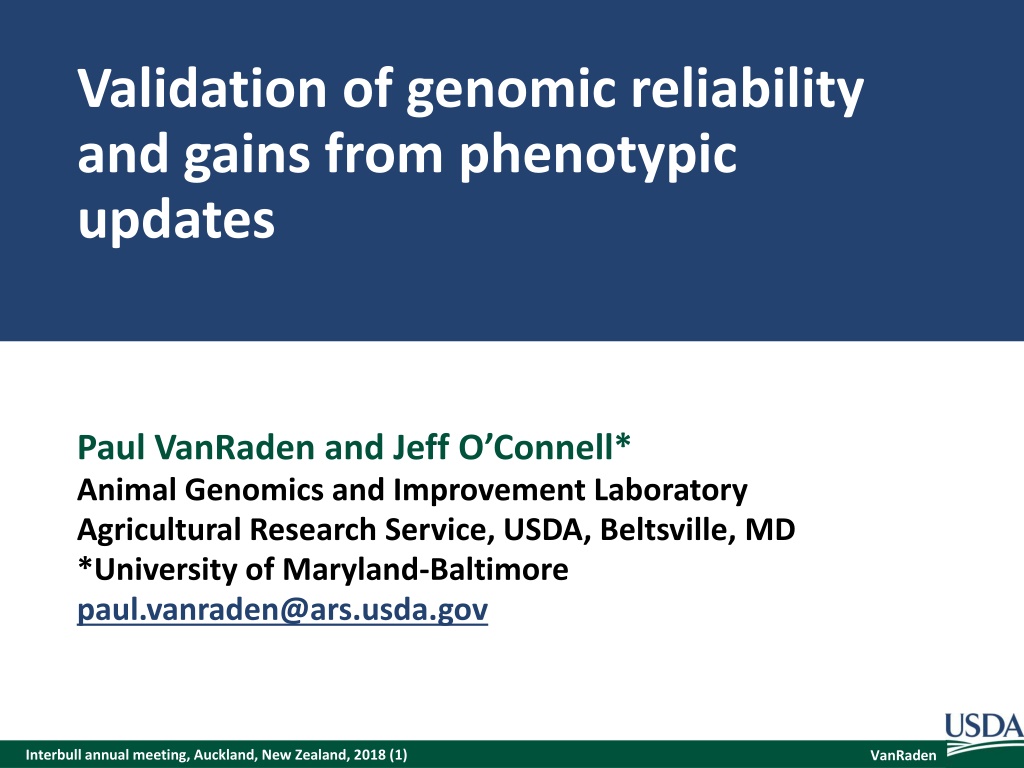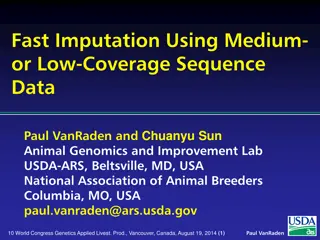
Genomic Reliability and Phenotypic Updates in Animal Genomics
Explore the validation of genomic reliability and gains from phenotypic updates in animal genomics research, featuring insights from Paul VanRaden and Jeff O'Connell. Topics include methods for computing genomic reliability, calculation vs. validation of REL, genomic reliability theory, and data validation techniques. Presented at the Interbull annual meeting in Auckland, New Zealand in 2018.
Download Presentation

Please find below an Image/Link to download the presentation.
The content on the website is provided AS IS for your information and personal use only. It may not be sold, licensed, or shared on other websites without obtaining consent from the author. Download presentation by click this link. If you encounter any issues during the download, it is possible that the publisher has removed the file from their server.
E N D
Presentation Transcript
Validation of genomic reliability and gains from phenotypic updates Paul VanRaden and Jeff O Connell* Animal Genomics and Improvement Laboratory Agricultural Research Service, USDA, Beltsville, MD *University of Maryland-Baltimore paul.vanraden@ars.usda.gov Interbull annual meeting, Auckland, New Zealand, 2018 (1) VanRaden
Topics Methods to compute genomic reliability Summarized by Liu et al (2017) GREL compared by Sullivan and Jakobsen (2014) Simple validation of genomic reliability Do actual EBV changes agree with published REL? Examples from USA and Intergenomics Gains in reliability from more frequent updates Similar math can determine the value of re- estimating marker effects more often Interbull annual meeting, Auckland, New Zealand, 2018 (2) VanRaden
REL calculation vs. validation REL estimation Adjust theoretical REL such as from SNP-BLUP-REL or from size of reference population Use prediction error variance (PEV) because correlations are biased downward by selection REL validation Similar to validating EBVs using truncated data Examine published REL for 6 traits and Net Merit Examine 3 breeds (HOL, JER, BSW) on USA scale Interbull annual meeting, Auckland, New Zealand, 2018 (3) VanRaden
Genomic reliability theory Selection reduces variance such that Var(EBV) < REL * Var(BV), but not prediction error variances (PEV): PEV = Var(EBV BV) = (1 REL) Var(BV) Variance of EBV differences are proportional to the difference in reliabilities regardless of selection. If EBV1and EBV2are earlier and later genomic evaluations with reliabilities REL1and REL2, then Var(EBV2 EBV1) = (REL2 REL1) Var(BV) If REL2is known, high, and accurate, then solve for REL1= REL2 Var(EBV2 EBV1) / Var(BV) Interbull annual meeting, Auckland, New Zealand, 2018 (4) VanRaden
Data to validate genomic reliability Published genomic evaluations from April 2014 Published genomic evaluations from April 2017 SD of difference in genomic PTAs REML estimates of true TA SD from Interbull MACE Example for Holstein protein validation bulls: Average published REL1was 0.76, REL2was 0.95, SD of change was 8.4, and REML TA SD was 17.5. The observed REL1for protein was calculated as Observed REL1= 0.95 (8.4)2/ (17.5)2= 0.72 Interbull annual meeting, Auckland, New Zealand, 2018 (5) VanRaden
Observed vs. published reliability, 2014 Trait Observed Published Diff Observed Published Diff Jerseys Holsteins Milk 73 68 +5 72 76 -4 Fat 72 68 +4 74 76 -2 Protein 71 68 +3 72 76 -4 Longevity 47 55 -8 65 70 -5 SCS 64 62 +2 77 73 +4 Preg Rate 63 52 +11 69 68 +1 NetMerit 68 64 +4 68 73 -5 Average 65 62 +3 71 73 -2 Interbull annual meeting, Auckland, New Zealand, 2018 (6) VanRaden
Observed vs. published reliability, BSW Trait Observed Published Diff Observed Published Diff Brown Swiss - USA BSW - Intergenomics Milk 62 63 -1 70 68 +2 Fat 64 63 +1 76 68 +8 Protein 57 63 -6 66 68 -2 Longevity 57 55 +2 63 61 +2 SCS 64 59 +6 71 66 +5 Preg Rate 56 51 +5 67 58 +9 Average 60 59 +1 69 65 +4 Interbull annual meeting, Auckland, New Zealand, 2018 (7) VanRaden
Discussion of BSW results Same software used by USA and Intergenomics Same data except PA in USA vs. Pedigree Index in IG Bias from dam s PTA and extra weight on PA Yield heritability reduced from 35% to 23% in Dec 2014 Small test used only 41 bulls with > 50 US daughters Full test with all 475 IG bulls gave observed REL much more similar because USA and IG both have only PI for foreign MACE bulls Interbull annual meeting, Auckland, New Zealand, 2018 (8) VanRaden
Phenotypic update frequency Suppose reliability increases steadily from REL1to REL2across a year. The gain in reliability from n updates per year (RELn) instead of 1 annual update should average: RELn= .5 (REL2 REL1) (n - 1) / n Suppose bulls increase from 75% REL1to 91% REL2 when 4 years old (no daughters to many daughters). Minimum gain is 0% with an annual update because the bulls would stay at 75% for the whole year. Maximum gain is 8% with instant updating. Bulls would average (75 + 91)/2 = 83% during that year. Interbull annual meeting, Auckland, New Zealand, 2018 (9) VanRaden
HOL NM$ average reliability by age 100 90 80 70 60 Bulls in AI 50 Females 40 30 20 10 0 <1 1 2 3 4 5 6 Interbull annual meeting, Auckland, New Zealand, 2018 (10) VanRaden
Phenotypic update frequency Interbull annual meeting, Auckland, New Zealand, 2018 (11) VanRaden
Reliability gains by update frequency Frequency Updates Young REL Marginal Gain Proven REL Marginal Gain Annual 1 73.0 75.0 6 months 2 73.5 0.5 79.0 4.0 4 months 3 73.7 0.2 80.3 1.3 3 months 4 73.8 0.1 81.0 0.7 2 months 6 73.83 0.03 81.6 0.6 Monthly 12 73.92 0.09 82.3 0.7 Weekly 52 73.98 0.06 82.8 0.5 Daily 365 73.99 0.01 82.97 0.17 Instant 74.0 0.01 83.0 0.03 Assuming that REL begins at 75% and is 91% 1 year later for proven bulls and begins at 73% and is 75% 1 year later for young bulls. Interbull annual meeting, Auckland, New Zealand, 2018 (12) VanRaden
Conclusions Exact calculation of genomic reliability is hard, but validation is easy Published USA REL averaged 2% too high for HOL, 3% too low for JER, and 1% too low for BSW Published Intergenomics REL averaged 4% too low for BSW traits because observed REL were higher Updating marker effects more frequently than 3 times per year could improve average REL up to 2.5% for recently proven bulls but < 0.3% for young animals Interbull annual meeting, Auckland, New Zealand, 2018 (13) VanRaden
Acknowledgements Interbull Working Group on Genomic Reliability (Zengting Liu, Martin Lidauer, Mario Calus, Vincent Ducrocq, Haifa Benhajali, and Hossein Jorjani) Council on Dairy Cattle Breeding and Intergenomics for data Suzanne Hubbard for graphs USDA-ARS project 1265-31000-101-00, Improving Genetic Predictions in Dairy Animals Using Phenotypic and Genomic Information Interbull annual meeting, Auckland, New Zealand, 2018 (14) VanRaden

